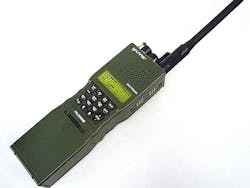Air Force special operations orders 1500 AN/PRC-152A software-defined radios from Harris RF
WRIGHT-PATTERSON AFB, Ohio, 22 Aug. 2014. U.S. Air Force special forces needed hand-held radios to conduct combat control, pararescue, tactical air control, and other sensitive operations. They found their solution from the Harris Corp. RF Communications segment in Rochester, N.Y.
Officials of the Battlefield Airmen branch of the Air Force Life Cycle Management Center at Wright-Patterson Air Force Base, Ohio, announced a $19.5 million contract to Harris RF last week for 1,500 AN/PRC-152A radios and accessories.
The Harris FALCON III AN/PRC-152A wideband networking handheld radio provides simultaneous voice and high-speed networked data using the Harris Adaptive Networking Wideband Waveform and the Soldier Radio Waveform, which is part of the Joint Tactical Radio System (JTRS).
The PRC-152A Type-1 certified handheld radio that handles high-bandwidth data services and narrowband legacy waveform support. The radio provides simultaneous voice and high-speed data services on the move, and works together with traditional narrowband line-of-sight and satellite communications waveforms such as SINCGARS, Havequick II, and VHF/UHF AM and FM in the 30-512 MHz range.
Related: Harris wins $400 million contract to replace legacy U.S. Special Operations radio equipment
The Air Force's Battlefield Airmen are the service's special operations force, and include combat controllers, pararescumen, tactical air control party members, and special operations weather technicians.
In addition to traditional radio waveforms, the Harris PRC-152A can handle wideband voice and data communications in the 1.2 MHz bandwidth, and Internet Protocol-based networking waveforms from 225 to 450 MHz.
The radio offers 5 Watts of power line of sight, and 10 Watts of power in satellite communications mode, and operates in frequency bands from 30-512 and 762-870 MHz. Its data applications include video and image dissemination; situational awareness and mapping; text messaging and email; and mobile device apps.
The PRC-152A's Adaptive Networking Wideband Waveform uses intelligent protocols that do not require the presence of a designated network control station; each radio automatically discovers and joins an authorized network.
Related: Navy to buy serial adapters from Sealevel Systems for AN/PRC battlefield radio systems
Ad-hoc networking not only enables automatic relay through an available station, but it also heals the network if a station leaves to assure network reliability, Harris officials say. The radio can operate either on secret networks, or on sensitive-but-unclassified Type 2 networks.
The PRC-152A also has the Software Communications Architecture (SCA) operating environment to make the move to software defined radio technology.
On this contract Harris will do the work in Rochester, N.Y., and should be finished by June 2019. For more information contact Harris RF Communications online at http://rf.harris.com, or the Air Force Life Cycle Management Center at www.wpafb.af.mil/aflcmc.

